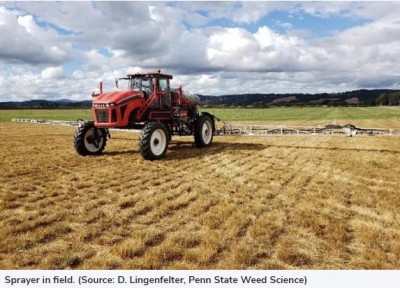Ways to Reduce Spray Drift and Other Considerations

By Dwight Lingenfelter, Penn State
The importance of keeping crop protectant applications on target continues to be at the forefront of growers' minds as well as people neighboring the farms. Making sure the product stays on the intended target is critical for the health of the plant as well as those surrounding the area. As most already know, wind often can derail your plans to spray. Keep in mind the objectives of any spray application are to balance productivity, efficacy, and prevent off-site movement of pesticides. It is also challenging to find a functional intermediate between controlling drift and not sacrificing herbicide (or other crop protectants) coverage and efficacy. Any change that is made to the spraying system (e.g., nozzle selection, ground speed, pressure, different pesticide formulations, adjuvants, etc.) will ultimately impact droplet size, potential drift, and possibly efficacy. In some situations, reducing spray drift can be easier said than done. Below are several things to consider to help keep the product on target.
- Spray at low wind velocities (3 to 10 mph). In general, winds are less of an issue early in the morning or late in the evening. Read the label carefully. For example, new dicamba product (e.g., Engenia, Xtendimax, etc.) labels call for applications one hour after sunrise until two hours before sunset to help reduce drift issues, while the Liberty (glufosinate) label recommends it is best to apply between dawn and 2 hours before sunset for optimal weed control.
- Reduce spraying pressures. Lower pressures allow for larger droplet sizes. Be aware that nozzles can produce different droplet sizes at different pressures. So, a nozzle might produce medium droplets at low pressure but fine droplets at higher pressures. However, some of the new drift-reducing nozzles are designed to require higher pressures for better spray coverage but still produce less drift than other types of nozzles. In most cases, contact herbicides such as Gramoxone, Liberty, Reflex, Cadet, etc. should be applied through nozzles that produce medium to coarse droplets, thus some of the newer drift-reducing nozzles might not provide the best spray coverage for effective weed control. However, increasing the spray volume can help to improve coverage.
- Increase carrier volumes/application rates. If possible, use 20 gallons or more per acre instead of 10 gallons or less per acre.
- Select the proper nozzles with coarse spray droplets. There are several companies that manufacture nozzles that are designed to reduce drift. Some examples include TeeJet's AI, AIXR, and TTI; and Greenleaf Technologies' TurboDrop XL and Hypro Ultra Low Drift noted in the article Selecting Spray Nozzles to Reduce Particle Drift. Of course, after selecting the proper nozzle, proper speed, pressure, and output must be determined and achieved as demonstrated in the Boom Sprayer Calibration video.
- Use lower spray boom heights. Make sure to use nozzles that have 110 degrees or more spray angle. This will allow the boom to be lowered more than nozzles with lesser angles but will ensure spray pattern and proper overlap is maintained. In general, for a boom with 20-inch nozzle spacings, maintain a boom height of 24 inches or less above the crop canopy.
- Reduce sprayer ground speed (less than 10 mph). Faster speeds will cause the boom to bounce and spray vortex to occur, sending spray droplets higher in the air.
- Use drift retardants. There are many good products on the market for this purpose. However, some are not compatible with certain drift-reducing nozzle types.
- Spray when wind direction is away from sensitive crops, homes, etc.
- Consider including buffer zones if sensitive crops are in adjacent fields. Some suggestions include a buffer of at least 250 to 300 feet near sensitive areas. If the buffer is included as part of the production area, treat the buffer with different products that will not affect the sensitive crop and/or spray that area during a different timeframe to avoid injuring the sensitive crop. Another option is to plant a cover crop in the buffer zone so there will not be an issue if it's injured or killed by spray drift.
- Invest in "high-tech" sprayers (e.g., pulse width modulation). Some of the new sprayers use a pulsing system to assist in a better application and drift reduction. Keep in mind, however, that some of the new sprayers increase pressure to maintain output if the ground speed is increased, thus producing additional fine droplets.
Upcoming Events
WEBINAR - Automated Milking Systems Efficiency: Balancing Focus on Individual Cows and System Optimization
May 8, 2024
Please join Cornell the SWNY team and MSU Extension for our talk with Dr. Pablo Silva Boloña on improving efficiency of Automated milking systems by focusing on milking settings for individual and group success.
Broiler Field Day at Sunny Cove Farm
June 6, 2024
Alfred Station, NY
Join us for a field day to explore broiler production, processing, and finances. Meghan Snyder of Sunny Cove Farm will be our host. She raises small batches of organic broilers, processing them on-farm under the 1,000 bird exemption.
Stockmanship and Stewardship 2024
October 25, 2024
Hamburg, NY
Save the date!! The event is one of 4 across the US and is a two-day educational experience featuring low-stress cattle handling demonstrations, Beef Quality Assurance educational sessions, facility design sessions, and industry updates.
Announcements
No announcements at this time.





